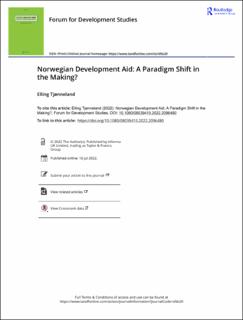| dc.contributor.author | Tjønneland, Elling | |
| dc.date.accessioned | 2022-07-25T16:37:09Z | |
| dc.date.issued | 2022-07-01 | |
| dc.identifier | oai:www.cmi.no:8387 | |
| dc.identifier.citation | in Forum for Development Studies | |
| dc.identifier.issn | 1891-1765 | |
| dc.identifier.uri | https://hdl.handle.net/11250/3008416 | |
| dc.description.abstract | Norway has remained committed to allocating one percent of its Gross National Income in developing aid. Poverty reduction has also stayed as an overarching objective for the aid budget. The commitment to these traditional pillars in Norwegian aid is also accompanied by major changes: reduced focus on partner countries and bilateral aid and an expanding emphasis on supporting global action, the rise of a flourishing number of new thematic priorities and delivery through multilateral channels. This article maps the evolving continuities and changes in Norwegian development aid since the early 1990s. It relies on an analytical framework based on Peter Halls work on paradigm shifts and his distinction between first, second and third order changes. The explanation for the evolving profile of Norwegian aid is found in a combination of domestic driving forces. Based on Matthew Wood’s concepts of puzzling and powering dynamics behind paradigm shifts the article identifies the forces behind evolving aid policies. One is depolitisation behind Norwegian aid– a broad political and popular support and consensus but limited debate leaving much space for foreign policy and selfinterest to shape implementation and selection of instruments. A second is linked to a change in the policy arena and the growing dominance of the Ministry of Foreign Affairs. This has led to a multifaceted and fragmented aid profile allowing various dimensions of development aid policies to be shaped by different interests and priorities. It has not yet reached a stage where we can identify a major break with the past and a radical policy transformation. The new focus on climate issues and migration may have the potential to change that and give self-interests a stronger influence over long-term development aid and its objectives. Changes in coalition politics may have the potential to change the majority behind the one percent target and the commitment to poverty reduction. | |
| dc.language.iso | eng | |
| dc.relation | Forum for Development Studies | |
| dc.relation | 3 | |
| dc.relation.ispartof | Forum for Development Studies | |
| dc.relation.ispartofseries | Forum for Development Studies | |
| dc.relation.ispartofseries | Forum for Development Studies vol. 49 no. 3 | |
| dc.relation.ispartofseries | Forum for Development Studies vol. 49 no. 3 | |
| dc.relation.uri | https://www.cmi.no/publications/8387-norwegian-development-aid-a-paradigm-shift-in-the-making | |
| dc.subject | Development Aid | |
| dc.subject | Paradigm Shifts | |
| dc.subject | Foreign Policy | |
| dc.subject | Development Poliicy | |
| dc.subject | Norway | |
| dc.title | Norwegian Development Aid: A Paradigm Shift in the Making? | |
| dc.type | Journal article | |
| dc.type | Peer reviewed | |
| dc.identifier.doi | 10.1080/08039410.2022.2096480 | |
| dc.identifier.doi | 10.1080/08039410.2022.2096480 | |
| dc.identifier.doi | 10.1080/08039410.2022.2096480 | |
